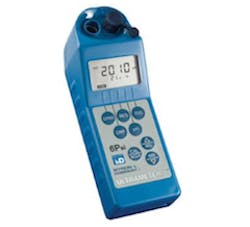Lafayette Textile Manufacturer Reduces Costs and Wastes
When Lafayette South America textile manufacturer in Bogota, Colombia, couldn’t find the little blue paper strips it had previously used to test for the presence of sodium hydrosulphite in its post reduction dyebath, it went looking for an alternative. Hyman Abadi, Lafayette’s cofounder, found a better testing solution and new automatic methods of monitoring and controlling chemical feeds in Myron L Company water quality instrumentation: the Ultrameter II 6 Parameter handheld digital meter; the 720II in-line ORP monitor/controller; the 720II pH monitor/controller; and the TechPro PH1.
Hyman’s technicians use the Ultrameter II 6P to instantly test for ORP in the textile dyeing process and continuous reduction washing of printed and dyed fabrics. Lafayette also uses the Ultrameter II to spot check ORP against the performance of automatic in-line monitor/controllers now in use.
Lafayette also uses 720II Series ORP Monitor/controllers to automatically control the amount of sodium hydrosulphite added to reduce the remaining solution in the textile bath. Before Myron L in-line Monitor/controllers were used, chemical had to constantly be added by hand to ensure product quality. Now, if the concentration is low, the monitor/controller opens a valve that releases the reducing solution into the bath. If it’s high, the valve remains closed. To ensure the process stays in control, spot checks on the reduction bath are conducted twice daily using the handheld Ultrameter IIs.
Myron L 720II Series pH Monitor/controllers are used to balance the bath by controlling the amount of caustic soda added to maintain the appropriate pH level. Accurately maintaining the pH ensures the effectiveness of the reducing agent, thereby decreasing chemical consumption. With sodium hydrosulphite, the pH must be maintained at around 10. If the pH drops below that level, it decomposes rapidly and loses its reduction efficiency.
In dyeing, the pH is kept at 5.5 to 6. This is important because the dyes themselves are susceptible to color changes outside of this pH range, until they diffuse into the fiber and become “fixed.” Once properly applied in the fiber, they are protected from these variations in pH. However, the unfixed dye remaining on the surface of the fiber must be removed in order to ensure subsequent proper wash fastness and color “bleeding”. This unfixed dye is removed by raising the pH along with the use of sodium hydrosulfite. Careful control of this reductive process removes the unfixed surface dye, without affecting the properly applied fixed dye. (The dyes must remain in their soluble form to enter the fibers of the fabric. They are then mechanically trapped as the pH level is raised in the reduction process and the unused dye is cleansed from solution.)
Maintaining the pH not only assists in the dyeing process, it also ensures reproducibility of color between the lab and the dyebath and from batch to batch by ensuring that the dyes are always applied in their optimum pH range of color stability. The solubility of dyes is dependent on pH and varies from dye to dye. If the pH of the dyebath is out of range for the dye type, the color will be off shade or incorrect altogether. Lafayette uses TechPro PH1 meters to measure grab samples as a confidence check against the equipment installation and functioning. PH1s are also in use throughout the factory for other solution quality control.
Due to Hyman’s implementation of basic water quality control in dyebath solutions, Lafayette is now generally able to use half of the chemicals it had previously used for this same process. Lafayette has drastically reduced costs, noxious fumes in the factory and the amount of harmful chemicals that must be removed before effluent is discharged into local rivers, creating a win-win situation for the company, its employees and the environment.
